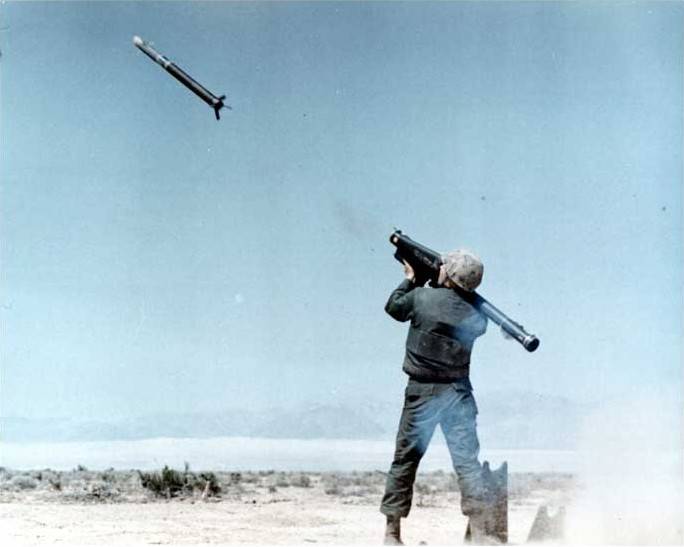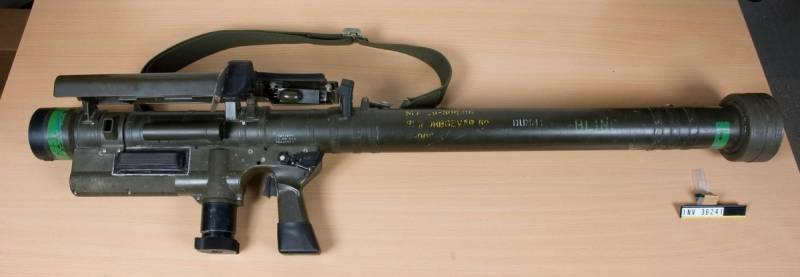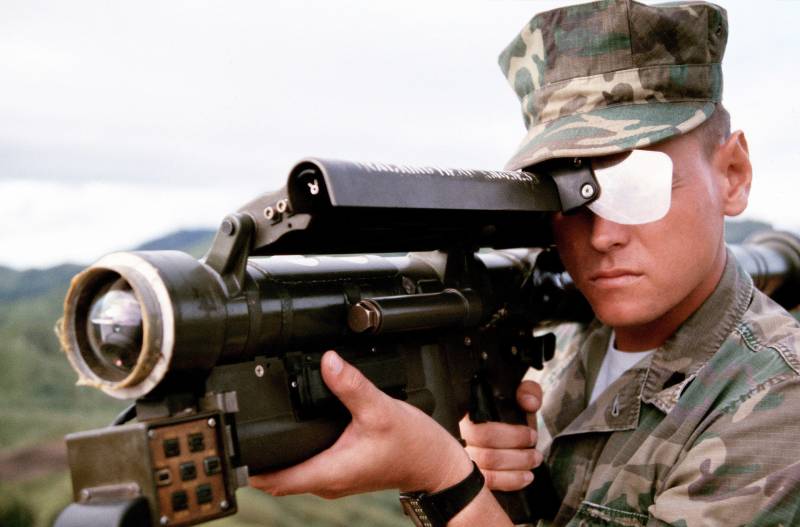"Manual" air defense systems. Part of 2. MANPADS FIM-43 Redeye
In total, during production in the US, 85 produced thousands of portable FIM-43 Redeye complexes, which were not only in service with the American army, but were also actively exported. MANPADS Redeye and its various modifications at different times were in service with 24 countries of the world, including Germany, Denmark, the Netherlands, Austria, Sweden, Jordan, Israel, Saudi Arabia, Turkey, Thailand and other countries.
The development of the first prototypes of a lightweight portable anti-aircraft missile system, which was intended to ensure the defense of military units on the battlefield, was launched by the American company Convair back in 1955 year. The first results of the work carried out were demonstrated by the US Department of Defense in 1956. But the truly full-scale work on the design of the new portable complex, designated “Redeye”, began only in April 1958.
In 1961, the first pilot firing of the new complex took place in the USA, which initially received the XM-41 index (later XMIM-43). 14 December 1962, a rocket fired from a man-made MANPADS, successfully hit an air target QF-9F, which flew at a speed of 450 km / h at an altitude of 300 meters. At the same time, the US Department of Defense signed a contract for the mass production of the complexes already in 1964, without waiting for the official adoption of the MANPADS into service with the American army. Such actions allowed to conduct full-scale tests of the portable complex in various operating conditions: from “arctic” to “tropical”. In 1968, the FIM-43 Redeye complex was finally adopted by the US Army and Marine Corps under the designation FIM-43A. Later on, three more modifications of MANPADS with letter indices B, C, and D were created in the USA.
The FIM-43 Redeye portable anti-aircraft missile system consists of the following parts:
- anti-aircraft guided missile in the transport and launch container;
- starter with optical sight and power source.
The launcher combines the elements that are necessary for launching a rocket. In preparing the MANPADS for combat, this device joins the transport and launch container with a missile. The SAM itself of the FIM-43 complex is single-stage, it is made according to the aerodynamic “duck” scheme with a cruciform shaped drop-down head at the head and a tail stabilizer after the launch.
At the head of the anti-aircraft guided missile, a thermal homing head was placed, which tracked the air target by the engine's thermal contrast using the atmospheric transparency window in the IR range. This HOS was cooled by freon, the detector of the thermal homing head was made of lead sulphide. For the missile seeker, there is a compartment containing the onboard equipment, which provides self-homing according to the proportional approach method. Next is a high-explosive fragmentation warhead with a shock fuse, a fuse and a missile self-destruct. In the tail section there is a single-chamber solid propellant rocket engine with starting and cruising charges.
The search for the air target and its tracking were carried out using an 2,5-multiple optical sight with a viewing angle of 25 degrees. Fuses - contact and non-contact. The aerial target was hit by a high-explosive fragmentation warhead weighing just over a kilogram. From within, the double-layered case of the warhead had special grooves of the planned crushing. Due to this, the explosion produced 80 fragments of 15 grams each, the speed of scattering of these fragments was up to 900 m / s.
The M171 launcher of this MANPADS included a launching tube made of fiberglass and served as an airtight container for an anti-aircraft missile, a launching device, a butt with a pistol grip and a cushioning stop, as well as a sight in the casing. The MANPADS launcher was equipped with a fuse, a gyroscope activation lever, a trigger, a target locking device, a fitting and a socket for connecting the battery. From the battery, power was supplied to the electric circuit of the portable complex and freon to cool the sensitive element of the IR receiver of the homing head. An aiming net was placed in the field of view of the optical sight, on which there was a main reticle and two nets for introducing pre-emption, as well as light alarms about the readiness of the GOS and its capture of the target.
The portable complex FIM-43 Redeye is designed to hit various low-flying air targets in conditions of good visibility. Shooting from the complex is carried out only on the catch-up courses. To hit a detected air target, the operator of the complex must prepare it for firing (switches the fuse to the firing position), captures the aircraft in the telescopic sight and follows it. At that moment, when the infrared radiation of the target begins to be perceived by the receiver of the GOS of the rocket, the audible and visual indicators are activated, which fix the target to capture the arrow. At this time, the operator of the complex continues to follow the target through the scope, determining by the eye the moment when the target enters the launch area, and then pulls the trigger. After this, the on-board power supply of the anti-aircraft missile goes into combat mode, the starting charge of the propulsion system is ignited. The missile system crashes out of the launch tube, after which, at a distance of 4,5-7,5 meter from the shooter, the charge of the main engine ignites. Approximately in 1,6 seconds after launch, the rocket warhead fuse was turned off. The total time of preparing the rocket for launch takes about 6 seconds (the time is spent mainly on spinning the gyro), battery runtime is 40 seconds. In the event that a missile misses the target, it will self-destruct.

The range of capture of the missile airborne target of the GOS depends on the radiation power of the aircraft, for example, for a tactical fighter it was 8 kilometers. The probability of hitting air targets that do not perform maneuvers was estimated by a single missile of the complex at 0,3-0,5. The equipment for identifying the nationality of the target was absent in FIM-43 Redeye MANPADS. The use of a passive thermal homing head on the target did not require the operator to participate in the flight control system of the missile defense system after its launch. The principle of "fired and forgotten" was implemented, which greatly facilitated the process of training MANPADS operators. The main combat unit of the portable complex in the American army was the fire crew, which consisted of two people: an arrow-operator and his assistant.
A curious detail is the fact that in the American specialized press at the end of the 1980, it was noted that the Soviet MANPADS "Strela-2" (9K32) was the result of the successful work of the bodies of military technical intelligence of the USSR, refined by the military-industrial complex of the Soviet Union with the use of reverse engineering methods and successfully tested and put into service even earlier than its American original.
The main disadvantages of the American FIM-43 Redeye MANPADS include:
- the ability to hit aircraft only in the rear hemisphere;
- not a wide viewing angle optical sight;
- low noise immunity of the thermal homing head, which made it possible to divert the missiles from the combat course with the aid of heat heat traps;
- short battery life - as a result, inexperienced and insufficiently trained operators did not always have time to get into the interval between the detection of an air target and the launch of a rocket.
American MANPADS "Redeye" quite actively used by the Mujahideen in Afghanistan against the Soviet aviation during the Afghan war. The fighting showed that the capture of targets of a thermal missile seeker is possible for helicopters not equipped with EVU (screen-exhaust devices), only at a distance not exceeding 1500 meters, and with such a device - only one kilometer. In almost all cases, the firing of thermal traps took the complex’s missiles off course, and the installation of LVA166 “Lipa” pulsed infrared interference on helicopters of the station reduced the probability that the FIM-43 Redeye portable missile system would hit almost zero. Also, the experience of combat use showed that both types of fuses used could not be called reliable. There were cases when the rocket flew a few centimeters from the helicopter’s body without exploding, cases were also noted when the rocket crashed against armor during a direct hit or simply got stuck in a duralumin skin.
For the entire period from 1982 to 1986, the Afghan Mujahideen shot down with the help of the American FIM-43 Redeye MANPADS two Soviet Mi-24D combat helicopters, as well as one Su-25 attack aircraft. In one of the cases, the missile landed in the NAR UB 32-24 block, which led to the detonation of the ammunition, the crew was killed. In the second case, an anti-aircraft guided missile landed in the stern, causing a fire. Two more missiles attacked the flame, which hit the Mi-24 in the gearbox and the root of the wing. As a result, the combat helicopter lost control and crashed, the crew died.
It is important to understand that the GOS of the initial models of missiles were focused on the contrasting temperature silhouette of the body of the aircraft among the relatively uniform background environment. At the same time, on advanced models of MANPADS, including the Stinger complexes of the first generations, the missiles were aimed at a target on a jet engine nozzle (it generated the most intense radiation in the infrared spectrum). Despite its shortcomings, the Redeye complex underwent several upgrades, remaining in service with the American army for a rather long period of time.
Performance characteristics of FIM-43C Redeye:
The range of targets hit - 4500 m.
Target hit height - 50-2700 m.
Maximum rocket speed - 580 m / s.
Maximum speed of targeted targets: 225 m / s.
Rocket caliber - 70 mm.
Rocket length - 1400 mm.
Rocket launch weight - 8,3 kg.
The mass of the missile warhead - 1,06 kg.
The mass of the complex in the combat position - 13,3 kg.
The preparation time for launching a rocket is about 6 seconds.
Information sources:
http://rbase.new-factoria.ru/missile/wobb/redeye/redeye.shtml
http://www.designation-systems.net/dusrm/m-43.html
http://www.dogswar.ru/strelkovoe-oryjie/granatomety/8184-perenosnoi-zenitnyi-.html
Open source materials



Information